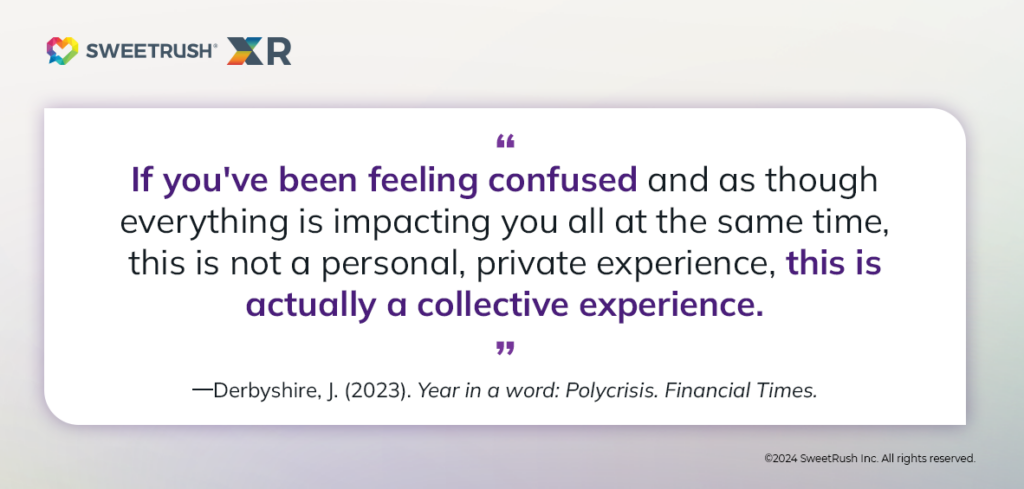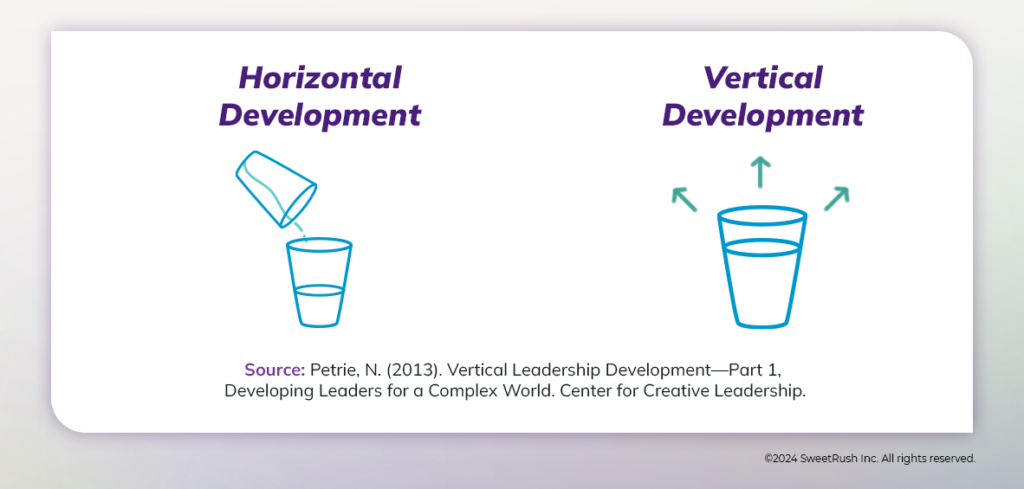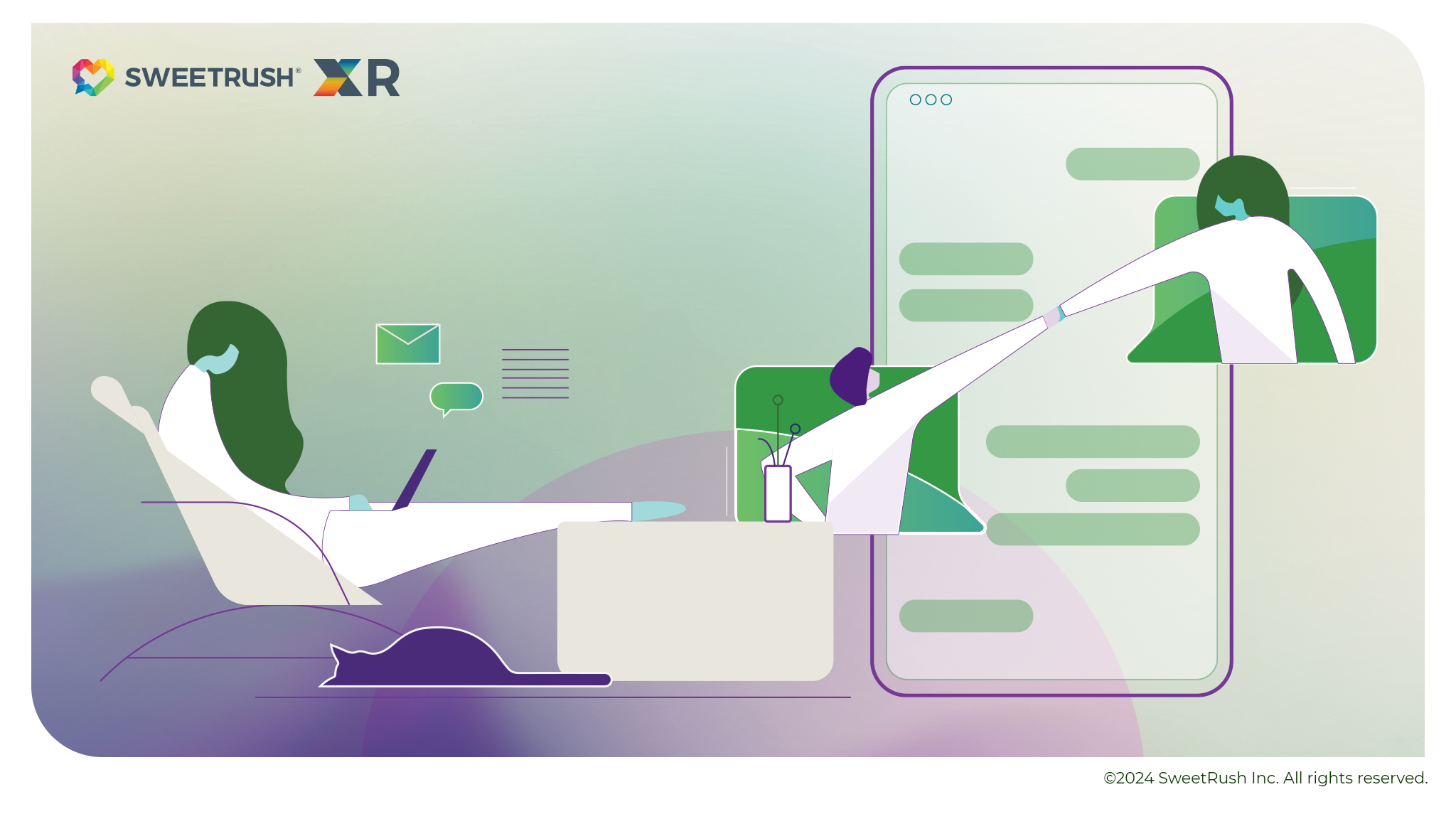Designing Effective Learning for Interesting Times
It’s no secret that our world is in flux—in fact, “flux” is a bit of a euphemism.
The convergence of geopolitical, economic, social, health, and climate emergencies makes for a volatile, uncertain, complex, and ambiguous (VUCA) global environment, also known as a polycrisis. Polycrisis occurs when numerous “shocks, deeply interconnected risks and eroding resilience” add up to an impact exponentially greater than that of any single factor alone.
No wonder so many of us are feeling a “pervasive sense of unease and uncertainty.”

We face an additional layer of uncertainty at our workplaces in the form of rapidly evolving technology, procedures, and client expectations. (Exhibit A: The impact AI has had in the span of a few months).
As much as we L&D folks value professional growth, it can be overwhelming to consider how much we need to learn and adapt just to keep current…and we’ve got to do it all while building solutions that help learners do the same.
Antidotes to Unease: Agility, Adaptability, and Resilience
Learning the ins and outs of any one technology isn’t the answer: L&D leaders need a change-friendly mindset and nuanced skills to help us identify “patterns among the noise” and “look at the world through multiple stakeholder perspectives.”
L&D professionals recognize this need, citing agility and adaptability as the No. 1 skills in demand at their organizations in 2022 and 2023.
Adaptability and agility are vital to learning teams and the learner audiences they serve…and they have a prerequisite: resilience. This ability to detach from reactivity and switch on the higher-order thinking we need to navigate our VUCA workplaces and world. And we need to cultivate it before we even think about adding role-specific skills and knowledge to our own to-do lists…or those of our learners.
But here’s the conundrum: During VUCA times, when humans are most in need of new ideas, mindsets, and competencies, we’re least able to take them in.
How can we help our learners (and ourselves) grow as people and acquire needed skills and knowledge, when uncertainty takes such a high cognitive toll?
Friends, we need to go vertical.
Going Vertical: Growing Resilience
It’s no secret that the stress of a VUCA environment decreases our capacity to take in new skills, knowledge, and methods. This type of learning, known as horizontal development, is the type of professional development offered by most workplace learning solutions.
In contrast, vertical development helps us cultivate the personal adaptability, agility, and resilience that expand our minds and create the space to accommodate those new skills, knowledge, and methods.
Vertical development expert Nick Petrie describes the relationship between vertical and horizontal development as akin to a cup and water: Whereas horizontal development fills our “cup” with more concepts, techniques, and skills, vertical development enlarges the capacity of the cup.

We grow our cups, or develop vertically, over the course of encountering, navigating, and reflecting upon a wide range of life experiences—an open-ended process that requires time and perspective.
Yet learners need future-ready skills…yesterday. Here’s how to grow their capacity without overfilling their cups.
Virtual Reality: Experience and Perspective, from Concentrate
What if we could speed up the learning process by distilling life’s most teachable moments and allowing learners to go back and replay?
That may sound like the stuff of science fiction, but plenty of L&D leaders are doing just that…with virtual reality (VR).
Learning in VR provides learners with the rich experiences, practice, and reflection that contribute to vertical development—with zero “noise” from irrelevant information. And when delivered via a headset with hand controls, VR experiences help learners shut out the pings, tasks, news alerts, and other distractions that shrink their “cup.”
In VR, learners can be transported into a digital twin of their workspace, an emergency situation, a fraught interaction, or an impossible scenario—and the 360-degree environment gives them the illusion of “being there,” or a sense of presence. Because it’s more like our 3D physical world than a 2D screen, VR learning content also helps to boost learning transfer.
The (VUCA) reality is that the skills learners need most are the ones that they (and their organizations) can least afford to get wrong. Yet learning requires practice, trial, and error.
L&D teams, too, are under pressure to find ways to upskill learners faster and better, without risks to safety, property, or relationships. VR helps minimize these risks by providing a safe practice environment where learners can practice, get feedback, and refine their skills at their own pace.
Here’s a fun paradox: The self-paced nature of VR learning experiences actually reduces time to proficiency. A PwC study focused on empathy training found that learners trained in VR develop new skills four times faster and feel 40% more confident in applying what they’ve learned.
This level of competence and confidence would normally take months or years to acquire. However, VR content empowers learners to confront a wider range of situations and challenges than they could experience in real life, at a pace that allows for the vital reflection that supports their vertical development.
The (Virtual) Reality Principle: Common Obstacles to a VR Learning Strategy
Here’s another reality of learning and skilling in a VUCA world: L&D leaders are increasingly asked to do more with less, and faster. Though they recognize the benefits of learning in virtual reality, they face a few common obstacles to implementing a VR learning strategy. These include:
- Scalability: VR works well with a smaller learner population, but can be a challenge to distribute to a large global audience. The hardware investment can be prohibitive, as can the learning curve in how to use VR headsets and hand controls.
- LMS compatibility: For better or worse, many organizations are married to a specific LMS or LXP, and all learning content needs to live under the same roof for reasons of security, practicality, and/or maintenance.
- Data analytics: Tracking learner completion and performance is another must-have, especially for compliance training and other high-stakes content. L&D teams, too, need access to the data to respond to learners’ needs, refine learning experiences, and demonstrate the ROI of learning solutions.
Read on to discover a solution that empowers L&D leaders to overcome all of these challenges and bring the benefits of VR to every learner.
Introducing WebXR: The Gateway to Immersive Learning
Meet WebXR, the web-based immersive learning solution that empowers L&D teams to create immersive experiences for every learner, with or without a headset. It’s also great for augmented reality (AR) and mixed reality (MR) content—but, for now, we’ll focus on VR. (Looking for an in-depth introduction to WebXR? Check out our comprehensive guide.)
Here’s how WebXR helps us clear those common hurdles:
- Scalability: WebXR experiences live on a server, like any website or web application. Learners can access them via a headset, for a fully immersive experience, or via their laptop or desktop computers, for an engaging, first-person video game-style experience. There’s no need to invest in hundreds (or thousands) of headsets up front; your organization can ramp up its immersive learning strategy over time.
- LMS compatibility: Thanks to our LMS Integration Tool (LIT), WebXR content can live happily in your LMS. Learners can even launch WebXR experiences from existing eLearning courses for a seamless experience.
- Data analytics: Immersive learning content generates rich data far beyond scores and seat time. Thanks to LIT’s customized Analytics Dashboard, your LMS and your WebXR experiences can “talk” to each other and capture the learner performance data that matters most to you and your stakeholders.
If you’re like lots of L&D leaders, you might be wondering how WebXR content looks on a desktop computer versus a headset, how it compares to a native VR application, and whether you’ve got a use case. We’ve got answers to these questions and more!
If you’re looking for a full walkthrough of WebXR, our expert hosts are here for you with this comprehensive webisode.
WebXR: Brought to Us by Interesting Times
Our current VUCA moment has some silver linings: As L&D leaders and innovators rise to meet it, we’re discovering new ways to meet the skilling needs of our organizations and learners. These strides in learner-centered design aren’t just effective; they’re also engaging, enjoyable, and a welcome respite from the traditional training to-do list.
As learners, technology, and the workplace continue to co-evolve, WebXR content empowers us to bring growth experiences to more of our people and help them build skills and resilience amid rapid change. It also empowers us to serve our learners better by providing them a virtual practice space where it’s safe to try, reflect, and try again—all while preserving their time and bandwidth.
Looking for ways to start the conversation about meeting evolving workplace needs with WebXR content? Inspire your stakeholders and leaders with talking points from our in-depth guide to this versatile learning technology. You’ll find a rainbow of use cases, success stories from fellow learning innovators, and details about WebXR’s data and LMS superpowers.




